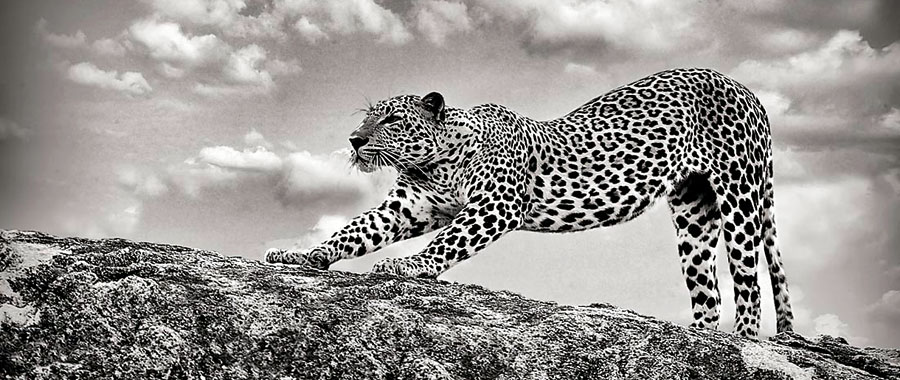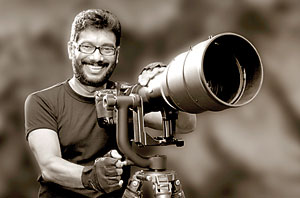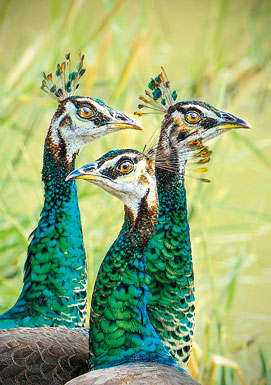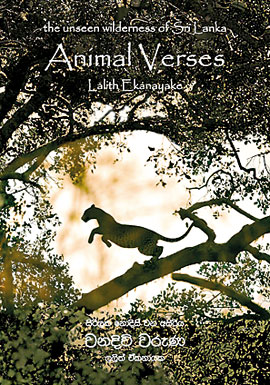Navy doc on a picture-taking mission
View(s):Treating his passion for the wilds with the same discipline and commitment he displays as Medical Director of the Sri Lanka Navy, Rear Admiral Lalith Ekanayake talks to Kumudini Hettiarachchi on the eve of the launch of his latest book and exhibition on the wilds
Seated across from Dr. Lalith Ekanayake in his office in the Fort, there seems to be many contradictions before us. Smartly-attired in his white uniform with many an epaulette befitting a high-ranking naval officer, the contradiction that jumps off the walls of his office and grabs the eye are the stunning photographs, a cosy ‘thunpath-rela’, the majestic stare of a leopard, the swirl of a proud pony caught in a gallop and a troop of monkeys taking their fill at a water-hole.

A leopard awakening from his slumber at Yala
Is there a contradiction, we wonder, as we chat about this and that just before Dr. Ekanayake launches his second book along with an exhibition of his photographs of the wild on May 16?
For, usually the photos that are displayed in offices are linked to a person’s career. Gradually, we realise that his career has complemented his passion for wildlife photography.
It is the same rigorous discipline and strenuous commitment that this Rear Admiral and Medical Director of the Sri Lanka Navy — who was the first to enlist in the armed forces as a medical student – applies to carrying out his duties as well as taking good photographs. Even in his medical career, being a Consultant Physician and Gastroenterologist and expert in Diving and Hyperbaric Medicine, may be the only one in Sri Lanka, have been achieved due to these core values.
In his pursuit of the perfect photograph, having slept in bunkers and roughed it out as a navy man, Dr. Ekanayake has not found it difficult to dig his heels in and stay hours on end in the wild. This is how he gets an “unusual photograph from a normal scene”, he smiles.
Never has it been a leisure or pleasure trip for Dr. Ekanayake when he is on a picture-taking mission. Having worked till midnight, he would set off for Yala early morning, to be the first to be in the queue to enter the National Park, one of his favourite haunts. “Eight hours in one place,” he would stay and it certainly is not a pleasure trip, after which he would jump back into his jeep and head to office for another day of work in Colombo.

Rear Admiral Lalith Ekanayake takes aim
Usually going alone, without his wife Rasanjalee and two daughters, although they are very supportive of his photographic endeavours and proud of his achievements, he would take with him scrap meals and lots of water, get into position and stay still until the right time comes to “capture” what he feels is the right photograph. “I only eat a little chicken and that too never while on a photo-taking trip,” he says, adding that then it would inevitably be a sparse vegetarian diet.
His creative streak had been visible even as a lad during his schooldays at Maliyadeva College, Kurunegala, where he took part in many activities linked to the arts, while being studious and also heavily involved in sports.
It was on entering the Colombo Medical Faculty that he became the “photo-catcher” to his batch-mates with a Ricoh ‘film camera’ that he bought with utmost difficulty for about a thousand rupees. After internship in his hometown of Kurunegala, where coincidentally his mother was the Chief Nurse, marriage and active service in the Navy followed, with tours of duty in the northern naval bases at the height of the war.
Securing his MD in 1995, he upgraded his Ricoh to a second-hand Nikon, during his foreign post-grad stint in Australia. This country holds a special place in his heart, with an unforgettable 10-day 10,000-km return trip from Adelaide to Darwin. Foolhardy it may have been to drive such vast distances in a basic Lancer car with many tyre-replacements on the way but the journey with his young family across the three deserts of Great Simpson, Tanami and Great Victoria, has not only left memories but a fat bundle of photographs.
It was the same Nikon that he used once he returned to Sri Lanka on his many forays to Yala, his regular haunt, but his eyes also light up when speaking about the “non-designated wildlife areas” such as Kala Wewa in the Dry Zone as he recalls the majesty at spill-time and Mannar and Delft island in the north.

Peahens at Yala
He points out that for him photography has not been a book-learning experience but very much trial and error. Never in his wildest dreams did he visualise himself as turning out to be among the best known for wildlife photographs. For what his trips yielded were in albums at home and only for family viewing. “I am still learning, there may be prizes and medals but it is a never-ending process, making mistakes and then creating new things,” says Dr. Ekanayake.
The photograph which changed his life, however, was the ‘Thunpath-rela’ (mother, father and baby elephant) that he took at Yala in 2008. Coaxed by family and friends to submit it for a calendar, the defining moment came when biodiversity expert Rohan Pethiyagoda met him and urged him to show him his photographs.
“Fantastic collection,” Mr. Pethiyagoda had said, querying from Dr. Ekanayake why he was “hiding” them. Why not a book, followed naturally?
‘The Untamed Road’ was born in November 2010 and 1,200 copies being snapped up immediately, was an indication of his prowess as a photographer.
With many photographic expeditions not only across the Palk Straits to Ranthambore and Kanha in India but also to Kenya, Zimbabwe and Botswana in Africa, Dr. Ekanayake has felt the time is right for his second coffee table book, ‘The unseen wilderness of Sri Lanka — Animal Verses’ as “our country is very beautiful”.
The African “captures” of the beautiful Golden-breasted Starling secured him the Gold Medal from the Swedish United Photographers’ Institute and the zebras made him the winner of the Monochrome in the wildlife category at the 57th International Photography Competition 2012 of the Photographic Society of Sri Lanka.
With future plans “of doing something else like macro-photography, may be landscapes” at Horton Plains, his aim with the current book is not to make money but motivate people to conserve the environment.
We need to make conservation a priority, not only among the people but also as a country, he adds.
Bilingual touch adds value to book
He has waded through mud and chest-high waters, trekked for miles, lain prostrate on wickedly-sharp corals while the searing sun has beaten down on him or become weather-beaten at sea to get those images now on the pages of ‘The unseen wilderness of Sri Lanka — Animal Verses’.
The common, the uncommon, the rugged, the stark, the tranquil, the strange poses or just the sunlight through the trees, all of the 130 photos printed on 170gsm paper to a matt finish come to life, finely displayed, juxtaposed with big borders of white.
An interesting aspect of this book is that it is “bi-lingual”, speaking through its pages to those fluent not only in English but also Sinhala. The tiny nuggets on the type of camera and whether hand-held, on a tripod or hidden in a bean bag, will aid the amateur photographer in experimenting with his/her own equipment.

The book’s cover shot was the National Geographic Editor’s Choice in 2011
The award winners from Sri Lanka nestle among the pages – two ponies on Delft which won the Bronze Medal in the wildlife category at the 57th International Photography Competition 2012 held by the Photographic Society of Sri Lanka; the Greater Crested Tern chick all alone which made him runner-up at the Wexas Travel International Awards United Kingdom 2012, the first Sri Lankan to do so and also got him the Bronze Medal in the nature category in the Austrian Trierenberg Super Circuit Awards 2013, once again the first Sri Lankan; and the Grey Heron with its meal in his mouth which won First Place in the wildlife category in the Chaaya wild and Etisalat Nature Photography Awards 2012, to name a few.
The Greater Crested Tern Chick was also the National Georgraphic Editor’s Choice, Photo of the Day and Photo of the month in 2012.
Who would think that the curves of elephant trunks of mother and baby would make a good shot or even the wrinkles of a pachyderm’s belly, while Dr. Ekanayake has “caught” a pair of Big Cat lovers in the act?
Birth, life, the struggle for survival and death, all encapsulated in the book for those who just cannot leave their humdrum routines, to only flick through the pages and be transported in an instant into the world of the wild.
‘Animal Verses’ printed in Singapore will be available at the launch at Rs. 3,750 on May 16 at the Harold Peiris Gallery of the Lionel Wendt and thereafter at Rs. 4,750 at Vijitha Yapa, Odel and Barefoot bookshops as well as www.books.lk
The exhibition of Dr. Ekanayake’s photographs will be held at the same venue from May 16 to 19 from 9 a.m. to 7 p.m.
Follow @timesonlinelk
comments powered by Disqus


